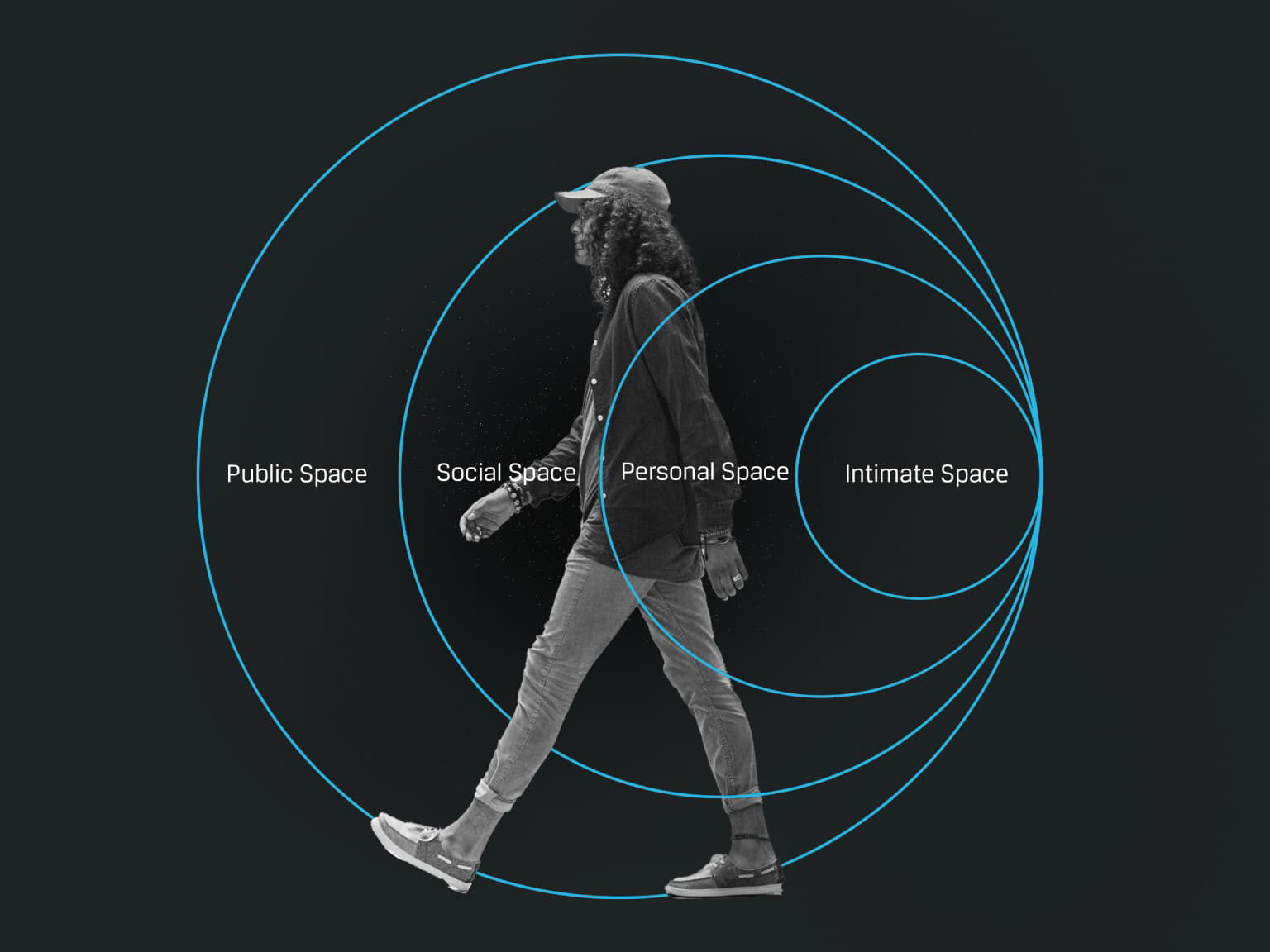The term immersive evokes images of gamers in headsets shooting at invisible enemies or exploring panoramic nautical landscapes, but immersive design goes far beyond the VR headset.
Immersive design is not simply a technology strategy, it’s a holistic approach to how people interact with their digital life and real-world surroundings in more natural ways. The goal: natural immersion. Natural immersion is an orchestration of the digital noise to create simpler, easier experiences for common real-world activities like having a meeting, driving somewhere new, or just finding your keys.
Designing Immersion into the Everyday
We look at every product as immersive, allowing experiences that are typically siloed to a device to be better understood and shaped within the larger contextual environment in which they live. The power of natural immersion comes in using new technologies to bring together disjointed experiences with casual human interactions. When we eliminate the need for users to manipulate disparate platforms and burdensome controls that distract and frustrate them, the results are products that are brilliantly simple to use as they reflect natural habits, movements, and user intentions.
Consumer products are beginning to build in naturalized interfaces that use multiple inputs in concert like voice, touch, sound, location, haptics, and biometrics. Our phones use all of these things in small, subtle ways that we rarely consider. Smart speakers have become commonplace. Young children address Siri, Alexa, and Google with native fluency. Your multi-generational family video call may seem like a technological comedy of errors, but its humble audio filters, lighting adjustments, and digital backgrounds are actually small but potent applications of augmented reality enabled by advancements in hardware sensors and machine learning. Products that utilize modern immersive techniques enable natural, seamless navigation between physical and digital experiences and result in deeper engagement with the brand and products.
This natural engagement with customers touches business, education, manufacturing, healthcare and retail. According to Forbes research in early 2022, augmented reality is rapidly becoming a norm in industrial and enterprise applications. Many designers are now creating industrial applications (65%) rather than gaming or entertainment software. ECom Dash reports that most ecommerce shoppers (61%) prefer making purchases on sites that offer AR, and almost half (49%) say that they’re willing to pay more for a product as long as they’re allowed to preview it in AR. Even healthcare is benefitting from AR with substantial changes in surgery, education, and diagnostics.*
AR adoption is a step in the right direction but it’s mostly still focused on a single technology and a single device. Natural immersion integrates things like voice, AI, ML, and spatial awareness within the larger device and service ecosystem. For example, a person purchasing furniture today can view a chair in AR to see how it might fit in their room. But these experiences require a user to find the furniture, tap the right button, and hold up the phone as a personal viewfinder. A more natural experience would be to simply speak, “Renovate my room” and see a remodel with new furniture and paint that fits your current style from various services. Not into the design? Use natural language to change the design, “Try a farmhouse style” for a new look. Someone else is there too? Merge your tastes into one design and display on a nearby TV screen everyone can see.
While news about the Metaverse may be changing the way we think about our future digital life, most people won’t be putting on a headset every day to engage with the digital world. Natural immersion meets people where they are through multiple input methods, real-time engagement, and machine intelligence.
Immersive Design Dimensions
Our recent Futureview report explores natural immersion as an important trend affecting business today. The hallmark of next-generation products will be stunningly sophisticated and elegant interactions that will make the digital and physical world more and more immersive. Contemporary immersive design techniques focus on three essential characteristics: Spatial, Sensory, and Seamless.

1. Spatial Environment
Spatial design is a foundational shift, releasing digital design from the flat 2D dimension that lacks the depth of the natural world. Digital experiences are rapidly being reimagined as rich immersive spaces that can be fully explored in natural ways—making digital interactions feel more like the physical world. As companies step into this new dimension, 3D spatial design and 360 degree XR experience design are becoming critical skills that add depth and dimension in intuitive ways. Companies are racing to expand their capabilities in spatial design as a foundation for richer, more dimensional interactions across experiences. As designers embrace spatial design, they must sharpen their understanding of the realities and physics of spatial movement. Two core principles to consider within spatial design include:
Design Principle
Ideate Dimensionally for Spatial Understanding
To design for multiple dimensions, designers must ideate in multiple dimensions. We live spatially every day, but translating that into immersive experiences requires specialized techniques and skills. Today’s 2D tools and methods are rapidly evolving to accommodate spatial ideation. Examples include dimensional grids for sketching, video walkthroughs to gauge spatial relationships, and modeling of scenes instead of screens. With deeper understanding of spatial relationships and structures, immersive experiences can be designed to feel more authentic and intuitive and to better align with human kinesthetic senses.
Design Principle
Guide Spatial Interactions with Proxemics
Spatial design considers both space and time as critical guides for interactions. Building on a concept known as proxemics, a spatial proximity model outlined by Edward T. Hall, degrees of distance within spatial environments often determine the level of information that can be displayed to a user or the nature of the most appropriate interactions. Spaces that are closer to the user are considered more personal and allow for more control over social interactions to set boundaries while farther distances are viewed as more public and may require more flexibility. By employing proxemics, designers can accelerate design from the ideation stage to production as they see designs come to life in 3D.

2. Sensory Engagement
Immersive experiences engage our senses on every level through voice, touch, sound, location, haptics, biometrics, and intelligence. Technology serves as the bridge between the digital and physical worlds.
Design Principle
Layer Multiple Senses to Increase Engagement
Integrating multiple senses into an experience is more engaging and feels more realistic to users. In real life one sense rarely works alone; multiple sensory inputs are combined to help people interpret what is going on around them at any given time. This layering helps people not only with awareness and perception, but also creates more memorable and emotional experiences. Designers can consider different senses and multi-modes of sensory stimulation when creating immersive products.
Design Principle
Take a Sensory Inventory & Start with What You Have
Before deciding to integrate more senses into a digital experience, designers should consider what senses are already engaged. It’s helpful to create a sensory systematics chart, a map of the various senses in play that outlines the role of each one at different points of the experience. Every experience a user has engages multiple senses around them. Even a user on their phone will have music playing, kids screaming, is sitting or standing, home or away—as a designer, you can choose to design for the full environment or ignore it. Taking the user’s immersive world into consideration will create coordinated experiences across all input methods.
Visit our blog series on Haptics & Neural Technologies

3. Seamless Presence
The most rewarding immersive experiences are seamless and evoke a sense of holistic presence. While the promise of seamless technology is ideal, the reality is that technology often gets in the way, creating disjointed, unnatural experiences. Moving from different platforms or spaces often presents excess friction, making it difficult to flow between them. To create virtual and physical presence in a single user session, designers must work to develop holistic, interoperable solutions. Interoperability can facilitate easier product entry and exit without destabilizing the overall experience. Technology companies must test and refine processes to reduce friction points across services. Immersive design can serve as the bridge between technologies, interfaces, and interactions for more natural interactions and more sophisticated products.
Design Principle
Design the In-Between Spaces with Care
New immersive experiences that blur physical and digital realities are being redefined as traditional concepts of place, and new liminal spaces are being defined in between. These transitions have the potential to jar users if not done correctly. Smooth entries and exits between experiences provide authenticity and comfort. Additionally, considering inputs and outputs as a consistent unified action will help a digital experience feel more natural. For example, consider both how a user triggers a certain interaction and the result they receive from a sensory perspective. The goal with any transition state is to reduce friction.
Design Principle
Treat Immersive Experiences as Fluid Ecosystems
New immersive platforms enable people to replicate their routines, interests, work environments, community, and even personal connections in digital spaces. Digital clothing, cars, pets, and virtual cities to live in serve as a backdrop for intimate virtual relationships. But as virtual and physical realities blend, it’s important to remember that the focus should be on fluid distribution across devices and touchpoints and not simply duplication. It’s less about literal mirroring and more about continuity within the overall ecosystem of experiences. To be truly seamless, immersive experiences must be adaptive to meet unique needs across contexts. While common physical affordances can create familiarity, immersive worlds have the opportunity to transcend known realities to create a continuous state of presence across distributed ecosystems.
Unified Experiences
The future of any brand will exist as much in the virtual world as in the physical one. As a result, companies that design immersive digital experiences into their products and brand strategies will see greater customer engagement and loyalty. Immersive design underlies virtually every product, customer touchpoint, and delivery strategy in this era of digital transformation. Companies must redefine their brand to equitably balance physical and digital worlds and ensure that product experiences meet new customer expectations.
As designers, we are inspired by Conscious Experience Design principles that result in more holistic products and innovations that seamlessly weave together virtual and physical worlds. We see immersive design as fundamental to creating products that enrich the senses and enable authentic, natural connections between individuals and groups.
To understand how this trend can affect your business, schedule an Immersive Design Accelerator Workshop with us. We’ll explore the opportunities together!
To learn more about our services please check out our overview on Immersive Design.



